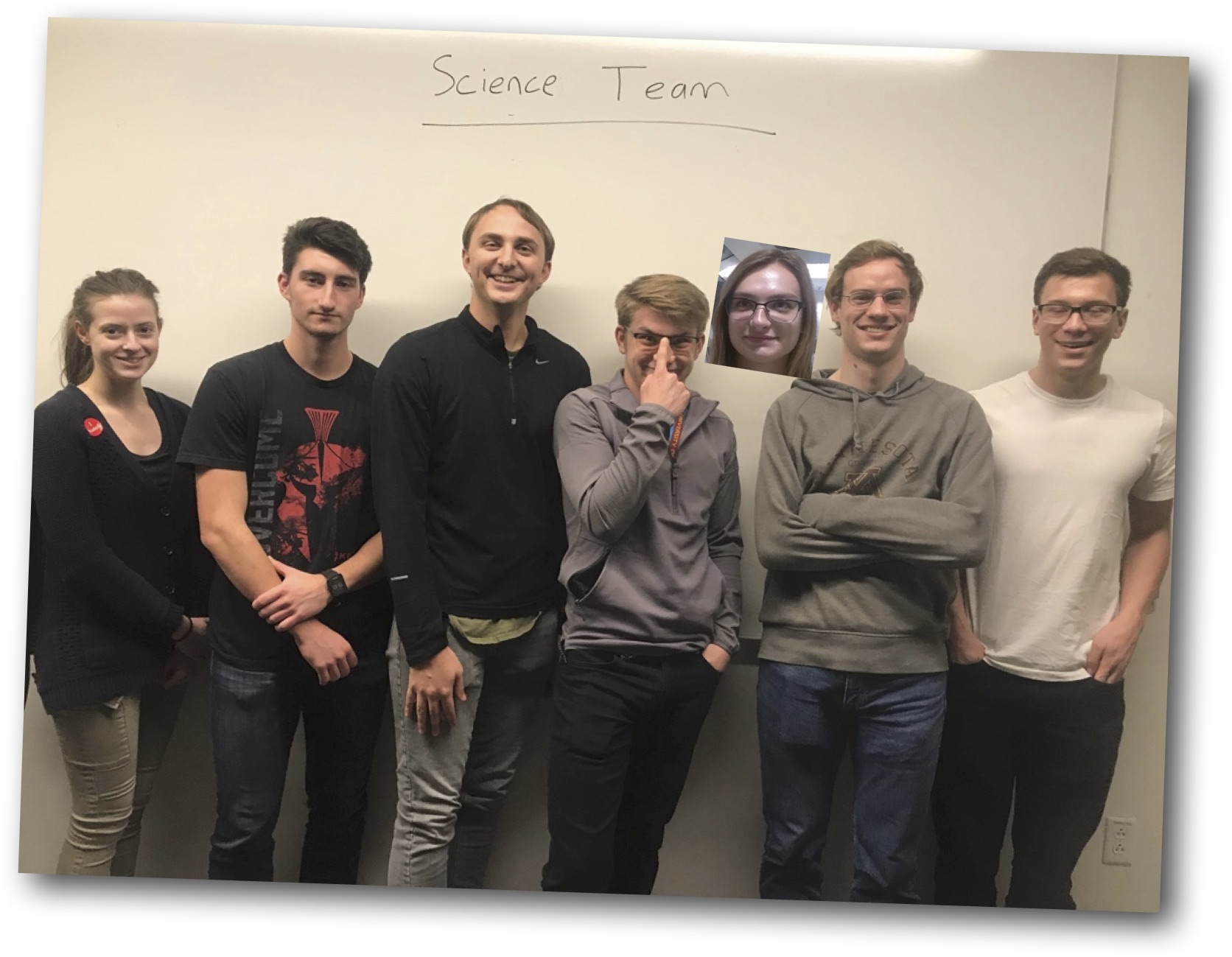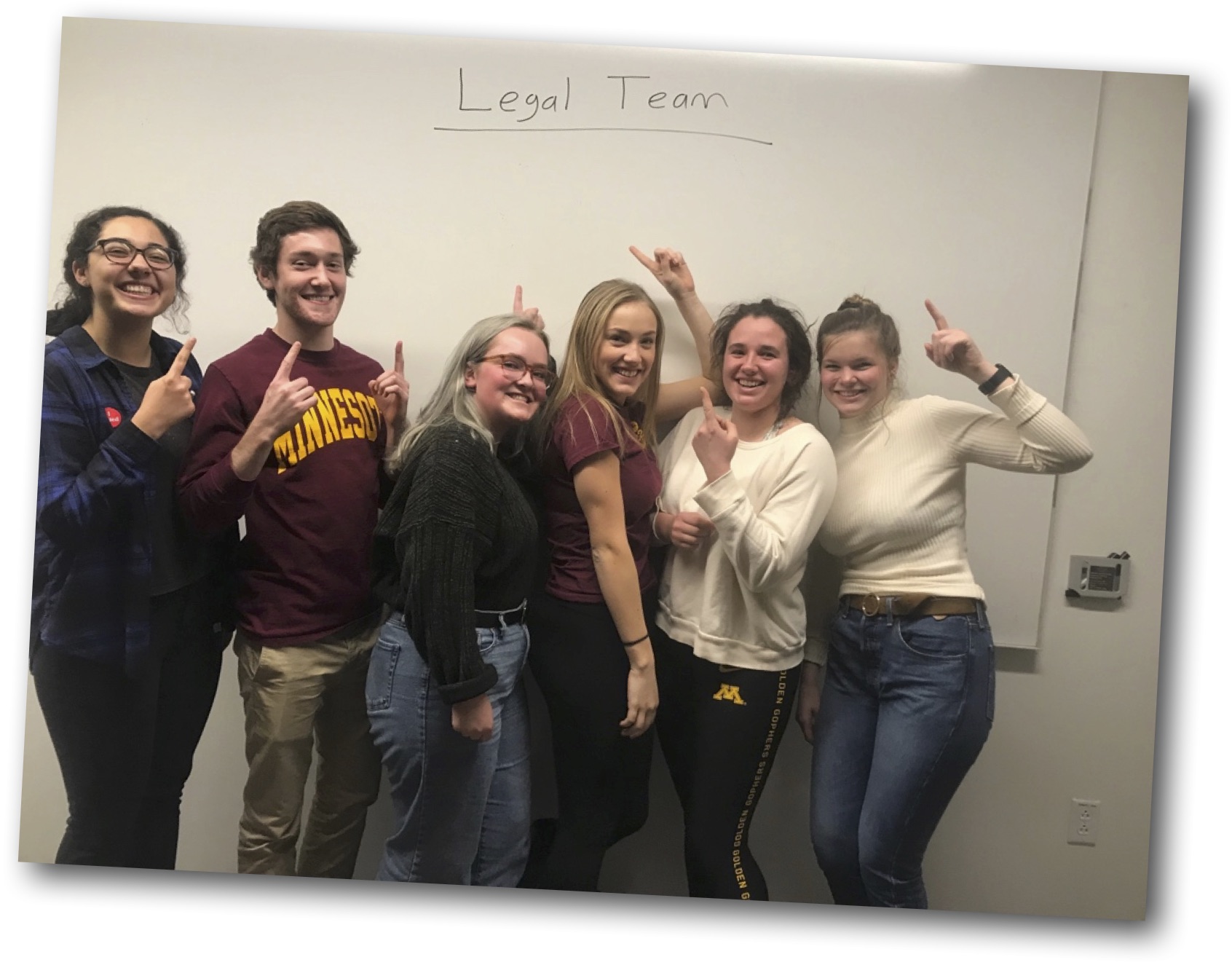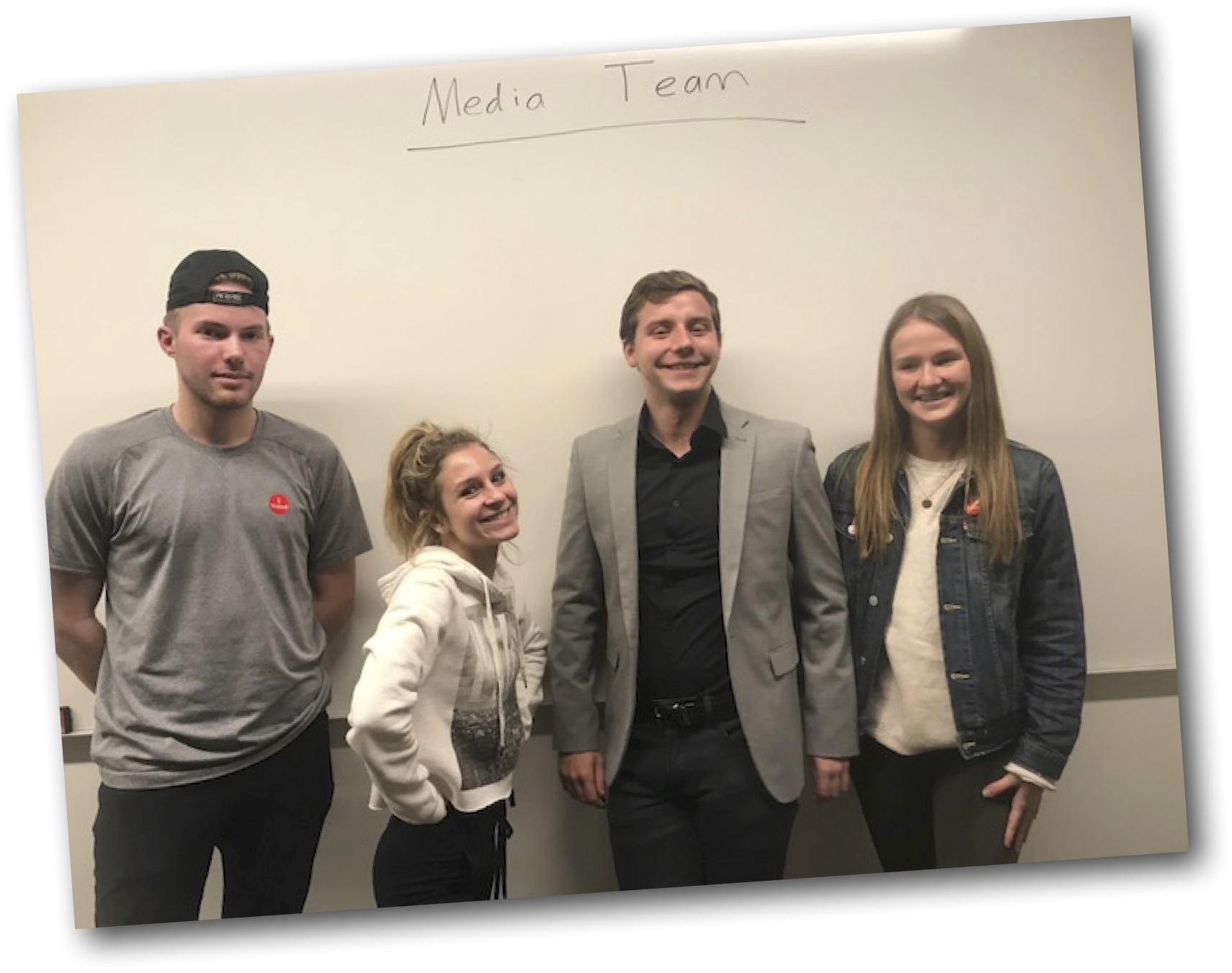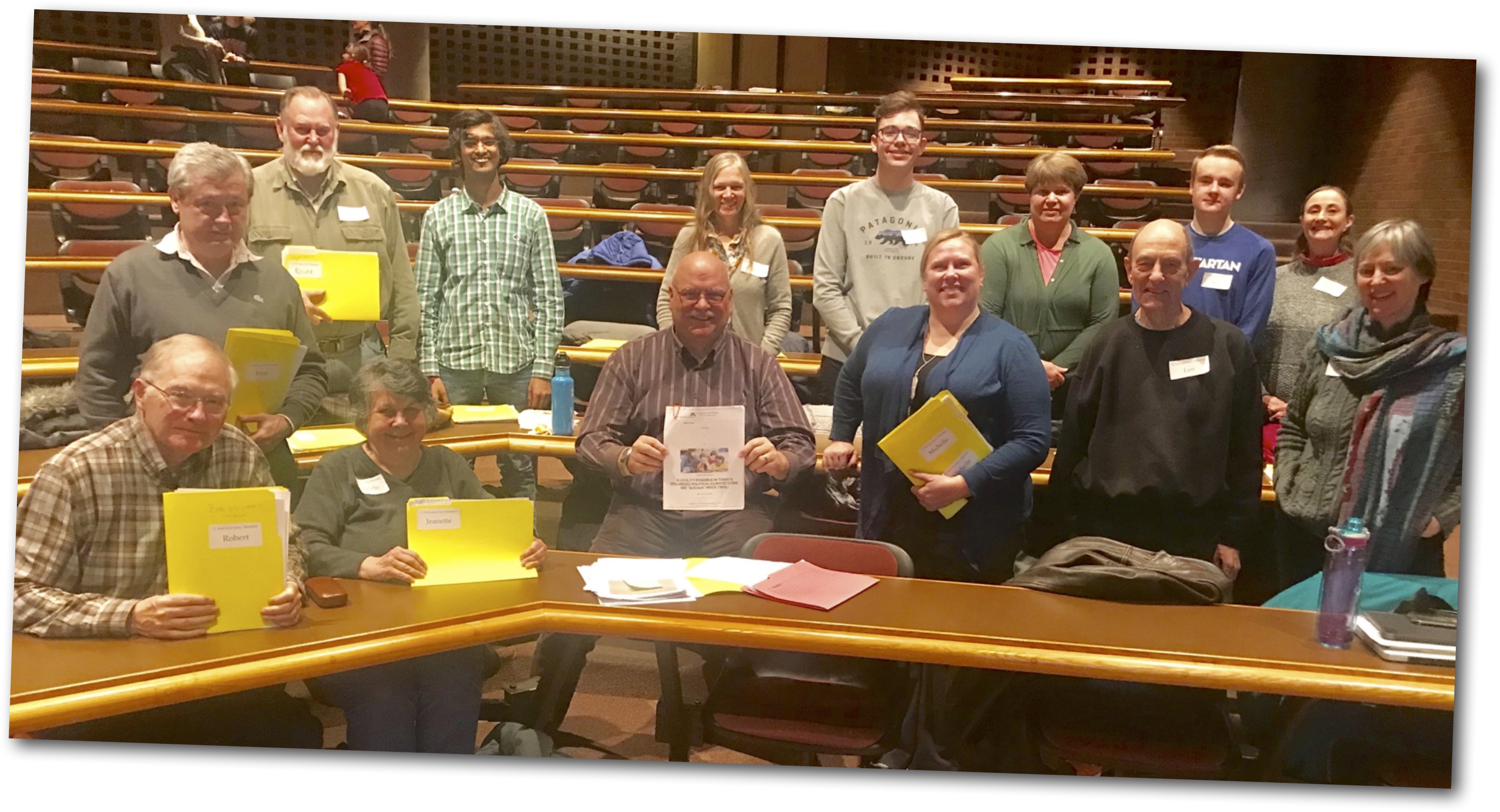
Archive of Fall 2018 Science Court Case
This page provides a summary of the Science Court case tried in Fall 2018. It includes the case statement, details on the student teams that prepared and tried the case, details on the jury, the closing statements by the pro and con teams, the jury decision, and a link to research that was collected by the science team and presented as evidence.
For much more information on this case with weekly updates and detailed reporting on the trial, visit the blog page.
For information on how to cite this Science Court case, click here.
2018 Science Court Case
The SciCourt case for Fall 2018 was
Should the State of Minnesota implement a 1:1 technology program in K-12 public schools, assigning one device (laptop or tablet) to every student for educational use in school and at home?
2018 Student Teams
The facts were researched by the students on the Science Team (shown below from left to right): Samantha Volkmeier (student opportunity and outcome disparities), Sam Moerbitz (student tech skills), Ryan Jonas (student mental health), Blake Paulson (teacher attitudes and beliefs), Lydia Fess (student physical health), Collin Bunner (student learning impacts) and Daniel Meyers (teacher training).

The arguments pro and con the case were made by the students on the Legal Team (shown below from left to right): Ishita Kamboj (pro), Matthew Nichols (con), Grace Lundgren (pro), Kylie Smith (con), Bayley McMenimen (pro), Kali Kilmer (con).

The preparations and trial were documented by the Media Team (shown below from left to right): Porter Larkin (video), Elise Eckert (social media), Luke Diamond (podcasts), Jill Peterson (reporter).

2018 Citizen Jury
The trial was held in front of a citizen jury (shown below from left to right): First row: Robert Williams, Jeanette Williams; Second row: Jorge Vinals, Tom Hanson, Michelle Kuseske, Len Jennings, Suzanne Garfield; Third row: Roger Meuhs, Tarun Gangwar, Julia Klatt Singer, Sam Theiste (did not participate in deliberation), Lynne Kolze, Sean Bearth, Betty Wheeler.

2018 Closing Statements
After six hours of presenting the evidence by the Science Team members and cross-examination by the Legal Team members, the following closing statements were made by the representative of the pro team (Bayley McMenimen) and con team (Matthew Nichols).
2018 Jury Decision
And the verdict is... the jury decided by a vote of 10 to 3 in favor of the con side against implementing a 1:1 Tech program in Minnesota. The jury also recommended several "third way" suggestions as a compromise between the pro and con positions. The jury majority statement, minority statement and third way suggestions follow below.
MAJORITY STATEMENT (10 jurors)
Our verdict is con because there was not enough evidence to support the implementation of a 1:1 program in the State of Minnesota. Missing pieces of critical information include:
- The differentiation between the effects of a 1:1 tech program vs. technology in general
- Information about technology that already exists in schools
- Other options for addressing disparity in access to tech
None of the domains had compelling evidence to show that 1:1 Technology programs are
sufficiently beneficial.
MINORITY STATEMENT (3 jurors)
We feel that too many questions remain (identified and unidentified), and with inadequate data, it is such that the program should be implemented on a limited basis.
- Funding options? Fund schools or tax cuts
- Opportunity disparity: evidence shows tech (1:1) levels the playing field
- While there might be initial barriers, this is natural and efficiency improves with time
- Need to start somewhere – why not here, and improve upon it?
- Evidence shows teacher attitudes improve with time
Third way suggestions collected from jury members
- Do 1:1 Tech, but computers stay at the school instead of students carrying them home each day. It eliminates my theft/harm to kids from thieves concern. It also allows more control of screen time.
- Fund a year of intensive training of teachers' use of new software before buying all the computers for the students. This could overcome teacher resistance by allowing them to be more comfortable with the technology before spending time learning it on their own as the program rolls out.
- Consider implementing 1:1 only at the high school level. Then track results and move it to younger ages if warranted.
- Adopt a 1:1 model only in those classes in which (i) the subject matter lends itself to it and is ready for the technology (i.e., quality and proven instructional software available), (ii) the teacher is familiar with the computer tools and software, and (iii) the teacher is willing to adopt a technology enhanced curriculum.
- The school would then have banks of loaner laptops for use in the classes in question. In effect, this would be a 1:n model instead (1:4, 1:5 ... depending on how many teachers are interested at any given school), and hence cheaper to implement and cheaper to support.
- Because so many kids have computers or laptops already, consider means testing to exclude those already technology enabled.
- Do means testing, mentoring and teacher training.
- Provide mentors for both, teachers and students, as well as more school counselors and other resource personnel in the lower-performing classrooms and schools, before any additional technology program is begun, and even prior to proposing a 1:1 tech pilot study.
- Incentivize ISPs to build out into rural districts in Minnesota where there is little/no access to broadband.
- In short, what is most needed would probably be targeted dollars and best determined on a school-by-school basis, rather than a one-size-fits-all statewide implementation of 1:1 tech.
2018 Research
The Science Team members reviewed over 80 articles (some of which were systematic reviews or meta-analyses that themselves reviewed multiple studies). Of these, 48 were evaluated in depth for scientific integrity. The evidence was challenged by the pro and con members of the Legal Team in a pretrial hearing. Following the hearing, both sides agreed to accept the remaining evidence and argue from a common set of facts.
All of the studies are available in Full Source Bank Spread Sheet. The full pool is under the "potentials" tab, the studies evaluated in detail (some of which were used as evidence) are under the "evaluations" tab.
2018 Citation
To cite this Science Court case:
Science Court. (2018). “Should the State of Minnesota implement a 1:1 technology program in K-12 public schools, assigning one device to every student for educational use in school and at home?" University of Minnesota. Retrieved from https://scicourt.umn.edu/2018-11-tech